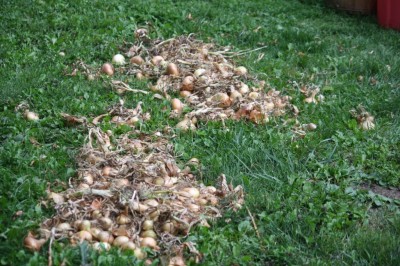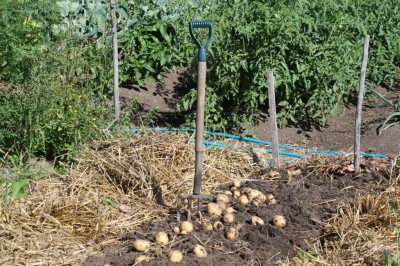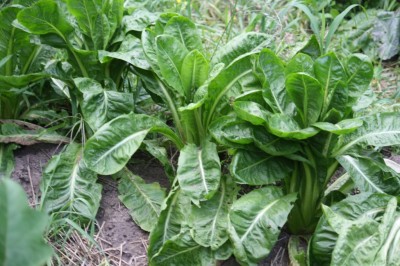by David Hinks
The Garlic Festival in Carp was a huge success with large crowds and even traffic congestion. (Unfortunately I was not able to get to the Perth Festival as well since Puppets Up was also on – why is everything scheduled for the same weekend?!?) One of the most striking things for me at Carp was the number of varieties of garlic that were on display (and for sale). There were an estimated 60 varieties available ranging from very mild to very hot. As I’ve mentioned in other columns most of our vegetables are available (but not easy to find) in great diversity. However very little of this diversity finds its way into the commercial food system for a number of reasons such as consumer preference, ease of growing, uniformity of growth and harvest, adaptability to mechanized harvesting and so on. For me this is a powerful reason to grow my own vegetables and to patronize local farmers’ markets. For example, in my seed catalogue I can choose from 39 varieties of lettuce, 18 varieties of carrots, 20 varieties of cabbage, 24 varieties of peppers, and 44 varieties of tomatoes. Local farmers will not be growing this full diversity but they will certainly have more choice than your local food stores. Join the food adventure and tease your palate with a myriad of different and exotic tastes. Who knows, there may be scope for other vegetables to have their own festivals!
If you bought garlic with the intention of planting it this fall it needs to be kept in a shaded cool place with good air circulation until it is time to plant it. I leave mine hanging in my garden shed. Do not store it in the refrigerator as this is too humid and may lead to rot. Plant it in the fall if you can as it requires a long cool growing season – garlic planted in the very early spring (as soon as the ground can be worked) will do almost as well. Some gardeners plant garlic in September – others believe that the last half of October is preferable. Garlic prefers well-drained soil with lots of compost worked in. Break the garlic bulb into individual cloves. Plant with the pointed end up 15 cm apart in rows 20 to 25 cm apart. Push the cloves into the soil until they are covered with about one or two cm of soil.
More of the early potatoes have been harvested. Yukon Gold is another early potato and is possibly the most popular potato grown and sold in Canada. It is a large variety of potato most distinctly characterized by its smooth eye free skin and yellow tinged flesh. This variety of potato was developed in the 1960’s at the University of Guelph. It is an extremely versatile potato as its waxy moist flesh and sweet flavor make it ideal for boiling, baking and frying but these potatoes will also stand up to grilling, pan frying, and roasting.
As shown in the following photo I had a reasonable harvest considering the damage that was inflicted on the plants by the potato beetles. Over the years I have found that the quantity of potatoes harvested from Yukon Gold has been considerably less than from other varieties. This is even when they have been grown side-by-side and received virtually identical treatment. However the taste and quality of Yukon Gold more than compensates. The soil in this garden is in fantastic shape and the bed will take very little preparation before it is ready to plant some fall greens.
Shortly after harvesting the garlic and hanging it to ‘cure’, I decided that it was timely to harvest the yellow cooking onions that had been planted as sets (small onion bulbs) in the last half of April. Most of the tops had fallen over and many of the tops were dead. As with the garlic the onions need to be cured if they are to be stored for extended periods of time. Curing simply means to allow them to air dry in a warm place for two or three weeks. This allows the skin to dry and harden thus protecting the inner flesh from outer contaminants. As shown in the following photo I am spreading them on the lawn for a couple of days for an initial drying (bringing them indoors at night). I will then spread them out in the garden shed and allow them to cure for several weeks. I will bring them indoors to store in a cool, well-ventilated and dry area, certainly before there is any risk of freezing temperatures.
 One plant that has grown extremely well this year is the chicory that is grown for forcing as shown in the following photo. The variety that I am growing is called Flash. The plants were started indoors from seed March 27 and transplanted into the garden May 20. After the first hard frost I will cut the leaves to within 2 cm of the base, dig the roots, and then pot them up in deep pots. This variety can also be placed in pots of moist perlite. I will then place them in a cool dark basement and wait for the creamy yellow Belgian Endives to appear (the timing will depend on the temperature of the basement). I cut them at the root with a sharp knife and slice into salads. [Warning: Do not attempt this if you have cats that have access to the basement.]
One plant that has grown extremely well this year is the chicory that is grown for forcing as shown in the following photo. The variety that I am growing is called Flash. The plants were started indoors from seed March 27 and transplanted into the garden May 20. After the first hard frost I will cut the leaves to within 2 cm of the base, dig the roots, and then pot them up in deep pots. This variety can also be placed in pots of moist perlite. I will then place them in a cool dark basement and wait for the creamy yellow Belgian Endives to appear (the timing will depend on the temperature of the basement). I cut them at the root with a sharp knife and slice into salads. [Warning: Do not attempt this if you have cats that have access to the basement.]
I continue to be fascinated by the possibilities for growing vegetables as decorative plants in a front yard garden or even in a more formal situation. Of course some trials are much more successful than others but for me that is part of the satisfaction of gardening – having fun with trying different things knowing that sometimes it will be spectacularly successful and other times maybe not quite so….
In the following photo the large jagged leaves of Globe Artichoke make an interesting contrast with the delicate flowers of plants such as phlox (even if we don’t get a harvest from the artichoke this year).
In this next photo the Thai Basil is really starting to show its purple flowers which provide a striking contrast to the geraniums and a nice complement to snapdragons with dark foliage.
 The next photo shows those same snapdragons against the much more neutral backdrop of Swiss chard.
The next photo shows those same snapdragons against the much more neutral backdrop of Swiss chard.






